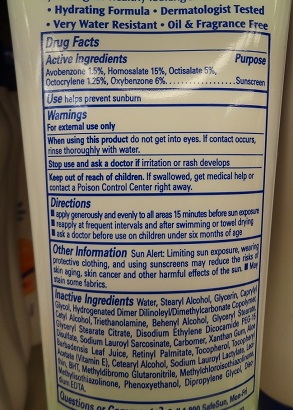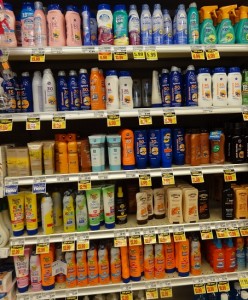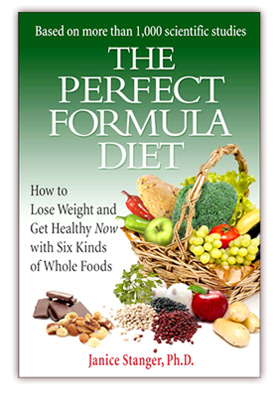
The beach gets crowded on a sunny day. The most popular activity is simply taking the sun. On an overcast day, people go home quickly.
Can a Whole Foods, Plant-Based Diet Do What Sunscreen Can’t?
Life on earth evolved with the sun. Plants, the base of the food chain, harness solar power through photosynthesis in leaves. Animals live off the energy and nutrients in plants. Over billions of years, plants and animals have perfected their relationship with the sun. Living things have evolved safeguards to benefit from the sun without succumbing to its power.
Yet today, sunscreen manufacturers would have you believe that the sun is your enemy, a cancer promoter. Instead, you are supposed to trust the chemicals in sunscreen to safeguard your health. The fact that sunlight is free and sunscreen drained $687 million from our pockets in 2010 may cause you to ponder who to trust – nature or industry.
Here are six dangers of sunscreen you need to know for your summer sun strategy.
ONE. Used as directed, sunscreen shuts down your natural production of vitamin D. A thin sunscreen layer spares your ability to produce this vital substance, but also does not protect as well against sunburn. A 2012 article in the British Journal of Dermatology concludes “When the amount of sunscreen and SPF advised by the World Health Organization (WHO) is used, vitamin D production may be abolished. Re-evaluation of sun protection strategies could be warranted.”
TWO. Several UV filters used as sunscreen ingredients have an estrogenic effect on your body (that is, they have a biological effect similar to the hormone estrogen). In fact, if you are a woman, the more sunscreen ingredient residues you have in your body the more likely you are to develop endometriosis. This painful condition is fed by estrogen.
While the concentration of individual filters in sunscreen may be low, a study in the journal Toxicology and Applied Pharmacology
found that mixtures of these chemicals had more potent estrogenic effect than each chemical alone had.
THREE. The estrogenic effect of sunscreen ingredients can also be harmful to wildlife. These chemicals get into natural waterways when sunscreen-coated people swim in them and also through wastewater. The UV filters linger and resist degradation in the environment.
The long-term and short-term effects of turning rivers and oceans into an estrogenic soup are not known. Residues of UV filters can be detected in fish. Scientists are observing alarming reproductive defects in wildlife, especially amphibians. Only tiny amounts of biologically active chemicals may be needed to induce harmful changes.
FOUR. When applied frequently, sunscreen stays in your skin for days. A European study found that, after sunscreen was applied three times a day for five days, skin had absorbed the chemicals and was itself resistant to UV light. The health effect of this has not been determined.
FIVE. Ingredients in sunscreen that have nothing to do with blocking UV rays can also be dangerous. One example of this is a form of vitamin A, often listed as retinyl palmitate or retinol on the product label. This ingredient may promote the development of skin tumors when it is exposed to sunlight.
Another example is fragrance, which can be hazardous even in “green” or “natural” products. Fragrance can contain up to several hundred unlabeled ingredients, some of which are hormone disruptors and probable carcinogens according to the Environmental Protection Agency.
SIX. Spray-on sunscreens get into your lungs, and from there are absorbed into your bloodstream.The nonprofit Environmental

Please read your sunscreen ingredients. Learn what they are and your effect on your body and the oceans. Your choice does matter. If something sounds like a chemical you don't want in your body, see if there are alternatives.
Working Group, in their annual sunscreen report, identifies spray-on sunscreens as a special hazard. Of course sunscreen is also absorbed directly through your skin to your bloodstream, but the aerosol droplets in your lungs intensify the whole body effect. Since the long-term consequence of this is not known, you probably want to avoid being a subject in this particular biology experiment.
The evidence that sunscreen protects you against skin cancer is weak and inconsistent. More than two million Americans develop skin cancer annually, and the incidence of this condition is rising. In fact, some studies have found an increased risk of melanoma, the deadliest form of skin cancer, among those who use more sunscreen. However, evidence indicates that sunscreen lowers the risk of slower-growing squamous cell carcinoma.
So if sunscreen is not the answer to summer sun hazards, what is? The evidence points to a strategy of getting enough sun to power adequate vitamin D production. The amount of sun needed for this varies by where you are, your age and weight, skin color, and other factors as I discuss in another post on understanding vitamin D.
However, it’s important to avoid getting sunburned, which does increase your risk of melanoma. You can do this by gradually building up to longer sun exposure as your body generates its natural defense against the sun’s potential to damage skin. Be sure to get out of the sun into the shade and/or cover up with protective clothing and a wide-brimmed hat before you get sunburned. If you decide to use a sunscreen, use one of the Environmental Working Group’s top picks. Never use indoor tanning beds, which produce way more UV rays than the sun does.
Nutrition has a key role in protecting against cancer, including skin cancer. The sun’s UV light generates free radicals that can promote
cancer. So foods high in antioxidants, which neutralize free radicals, are protective. While high quality studies of the relationship of diet to skin cancer are scarce, research indicates whole plant foods such as green tea, vegetables, and fruits lower the risk of skin cancer, including deadly melanoma.
A whole food, plant-based diet also slows skin aging and wrinkles. Once again, the hero is the antioxidant power of whole plant foods. Is it just a coincidence that summer’s tastiest and most nutrient-dense fruits – melons, berries, cherries, peaches, nectarines, plums, grapes, apricots, and more – are abundant at just the time our skin most needs protection against too much sun exposure?
Formulating your summer sun strategy can be a complex balancing act. The right choices for you depend on any history of skin cancer, the kinds of outdoor activities you enjoy, how much time you spend outside, where you live, your personal characteristics (such as age and skin color), and more. This is an important decision, so get as much information as you can before you act.
If you liked this post, you may want to learn more about EWG resources and four other sites that provide invaluable information on toxic chemicals in personal care and household products. You also may want to find out about the President’s Cancer Panel, and their honest report Reducing Environmental Cancer Risk.
Intrigued? Now you can use our Whole Foods Blog Finder to target informative, fun postings on whole foods, plant-based diets. Quick information at no cost!
Blog posting by Janice Stanger, Ph.D. Janice authored The Perfect Formula Diet: How to Lose Weight and Get Healthy Now With Six Kinds of Whole Foods. This easy-to-follow eating plan is built on a whole foods, plant-based diet that can prevent, and even reverse, most chronic disease. Janice has a judicious love of the sun, tempering her enthusiasm for the outdoors in summer with the commonsense precautions in this post. Especially the part about enjoying summer fruit.
Tags: cancer, environmental degradation, Environmental Working Group, fish, getting healthy, phytochemicals, Plant-based nutrition, President's Cancer Panel, summer, sunburn, sunscreen, vitamin D, whole foods plant-based diet







I went plant based whole foods in November 2011. I’ve been smashing the coloured vegis all summer (in Sydney, Australia). In January, after building a bit of resistance with a tan, I stopped using sun block. 3 hours sitting on a surf board without protection on my shaven head was not enough to give a burn. Bit tender overnight but fine by morning. Supposedly permanent damage to my eyes (white skin growing over the eyeball) has now nearly reversed. This is not science as there’s just my experience and it’s a very narrow one, but I feel so much better in my skin than I used to. Anybody I tell looks at me like I’m mad and dismisses it as the rankings of a crackpot, so I’m glad to read this blog and relieved I’m not bonkers.